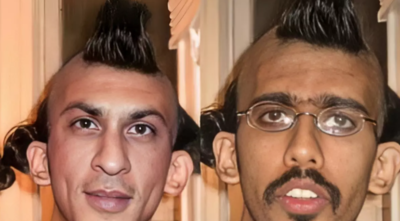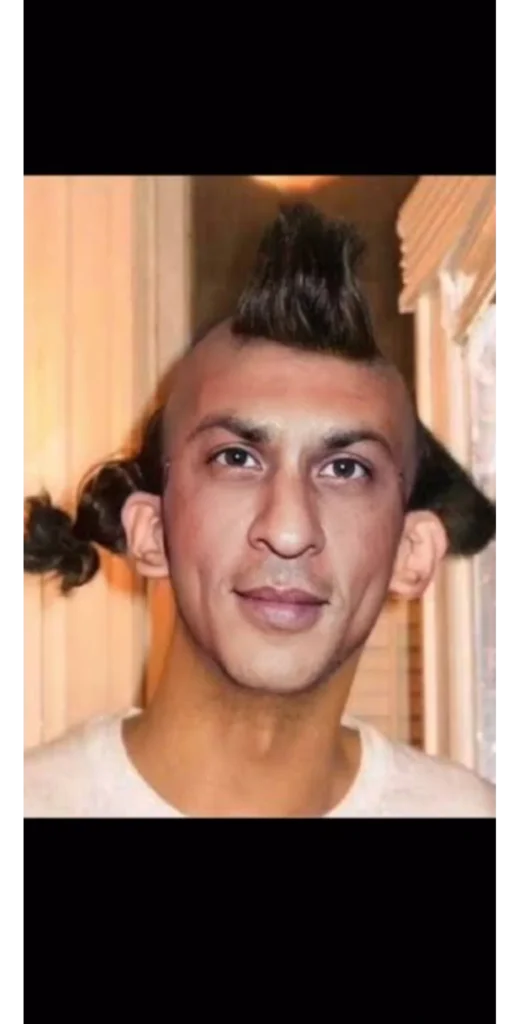
One of the biggest viral trends on social media right now is the “Hakla Shah Rukh Khan” meme. It has taken over platforms like Instagram, WhatsApp, YouTube Shorts, and meme pages. Even after multiple attempts to remove it, the meme keeps coming back in creative ways.
The word “Hakla” means “to stammer” in Hindi. This meme shows a weird, distorted cartoon image that makes fun of Shah Rukh Khan’s old movie dialogues, especially the famous “K-K-K-Kiran” line. The image is not real—it’s a parody that exaggerates his expressions and speech.
This meme first started years ago but didn’t get much attention. Recently, it went viral again when some people began posting it under promotional posts for Shah Rukh Khan’s new movie. They started spamming the comment sections with this meme. Platforms tried to remove it, but fans found clever ways to avoid filters by changing spellings or using symbols to write the word “Hakla.”
The meme is now used to show moments of confusion, silence, or hesitation in a funny way. People relate to it because it represents situations where they don’t know what to say or feel awkward. As a result, it spread quickly across the internet.
What’s more interesting is how this trend expanded. Other celebrities were also made into memes. Salman Khan became “Suja Salman,” Akshay Kumar was called “Banana Akki,” and even politicians were not spared. These funny names were used in combination memes and reels, making the trend even bigger.
Despite criticism, people continue to share this meme. Some say it’s harmless fun and part of internet humor, while others feel it’s disrespectful. Still, it shows how meme culture works—once something catches on, it becomes hard to stop.
This trend proves that the internet has its own way of keeping jokes alive. The more someone tries to delete or ban it, the more creative people get in spreading it again. It’s a powerful example of how social media users control what becomes popular, not the platforms themselves.
Behind the Meme: Why “Hakla SRK” Refuses to Die

The reason why the “Hakla SRK” meme is still alive isn’t just because it’s funny—it’s because it has become a part of internet culture where users enjoy breaking rules in creative ways. Whenever something gets banned or taken down, people often push back harder. That’s exactly what happened here.
After platforms tried to delete the meme, users didn’t stop. Instead, they changed the way they posted it. Some wrote the word in code form like “H@kl@,” while others used cartoon versions or ASCII art to avoid detection. These tricks helped the meme survive and grow even more.
Another reason this meme became stronger is because of community power. Once meme pages and fan accounts started sharing it daily, it became part of the online routine. People began using it in unrelated situations too—like during cricket matches, awkward interviews, or political debates—making it more than just a joke about SRK.
This trend also highlights the shift in meme culture. Earlier, memes were just for fun. Now, they are also used as tools for commentary, trolling, and even rebellion. The “Hakla” meme turned into a small movement. It’s no longer just a laugh—it’s a signal. A symbol that says: “We do what we want, not what platforms tell us.”
Even younger users who don’t know the origin of the meme are now part of it. For them, it’s not about Shah Rukh Khan anymore. It’s just a viral format to express awkwardness, confusion, or delay. In that sense, the meme has taken on a new identity. It has grown beyond its creator or subject.
At the same time, there is a serious side to this. Many people feel that mocking speech disabilities or imitating someone’s voice for laughs is not okay. They argue that this meme spreads wrong messages, especially to younger audiences. That’s why some content creators have publicly requested people to stop using it.
But the truth is, once something becomes a meme, it’s almost impossible to fully erase it from the internet. That’s what we’re seeing here. The meme’s life has now entered a phase where people aren’t just sharing it—they’re remixing it, turning it into songs, shorts, and templates. It’s evolving daily.
In the end, the “Hakla” meme is not just a funny image anymore. It’s a reminder of how strong online communities are. It shows how fast content moves, how rules are bent, and how culture is created by the people—not by algorithms or authorities.
The “Hakla SRK” meme is more than just a viral joke—it’s a powerful example of how internet culture works today. What began as a parody has turned into a movement shaped by creativity, rebellion, and collective humor. Its rise shows how quickly a simple meme can spread when people feel connected to its message or style.
Despite criticism and takedown efforts, the meme kept evolving because users refused to let it die. They adapted, disguised, and reshared it in new forms. For some, it’s just fun. For others, it’s a symbol of how digital communities can control trends, not platforms or authorities.
This trend reminds us that memes are no longer just entertainment—they’re cultural signals. They can unite people, create debates, challenge rules, and shape online behavior. Whether seen as harmless humor or disrespectful content, the “Hakla” meme has left its mark on 2024’s digital history.


